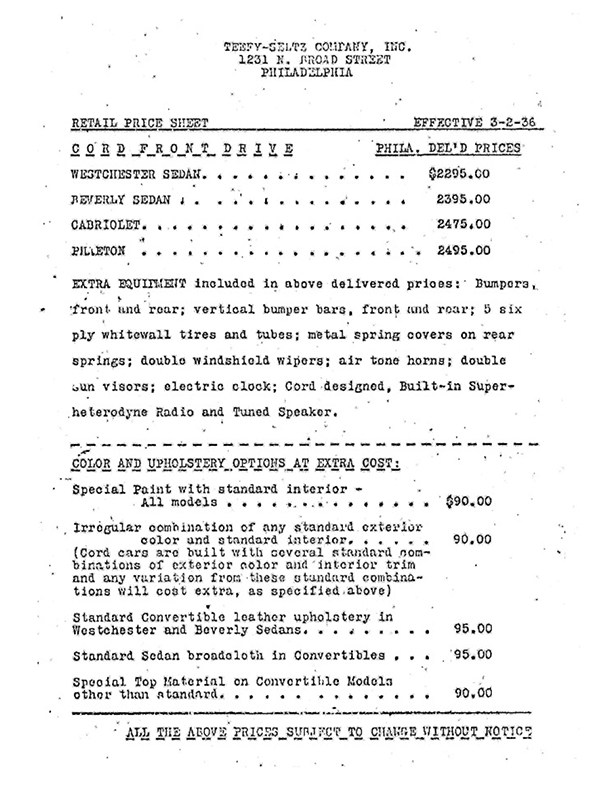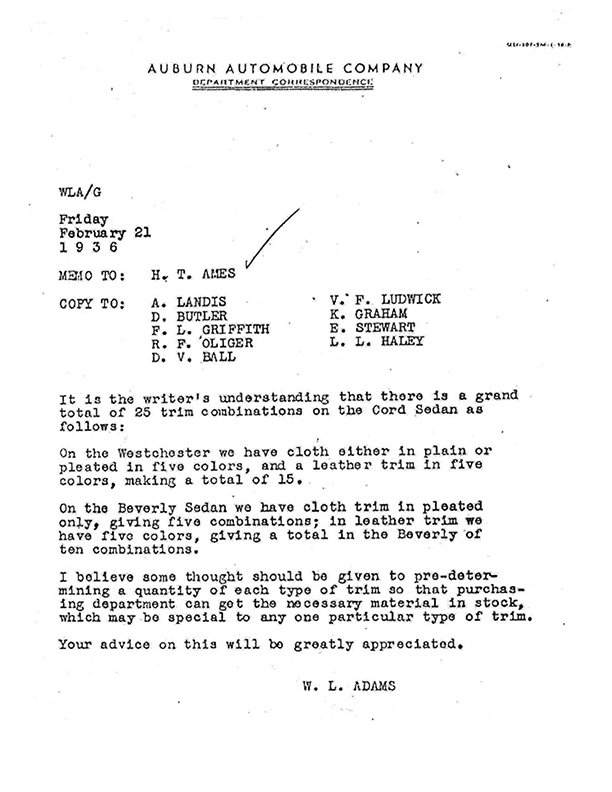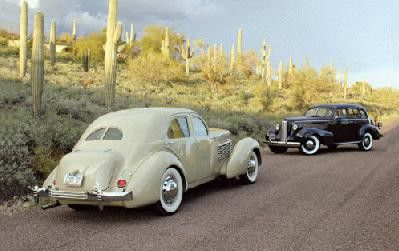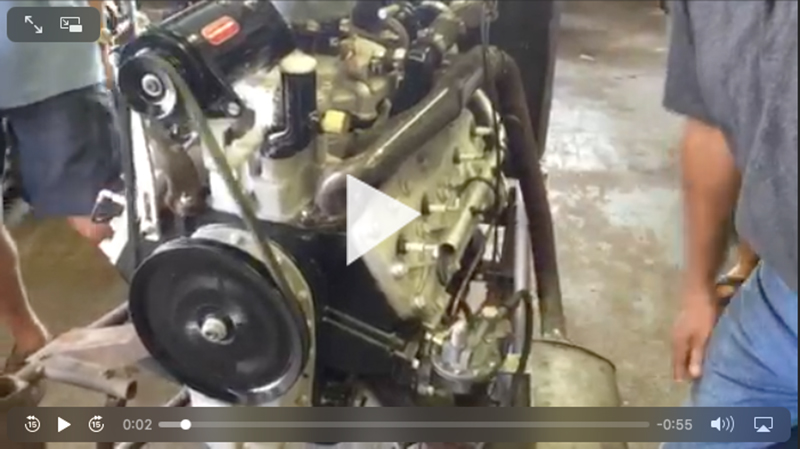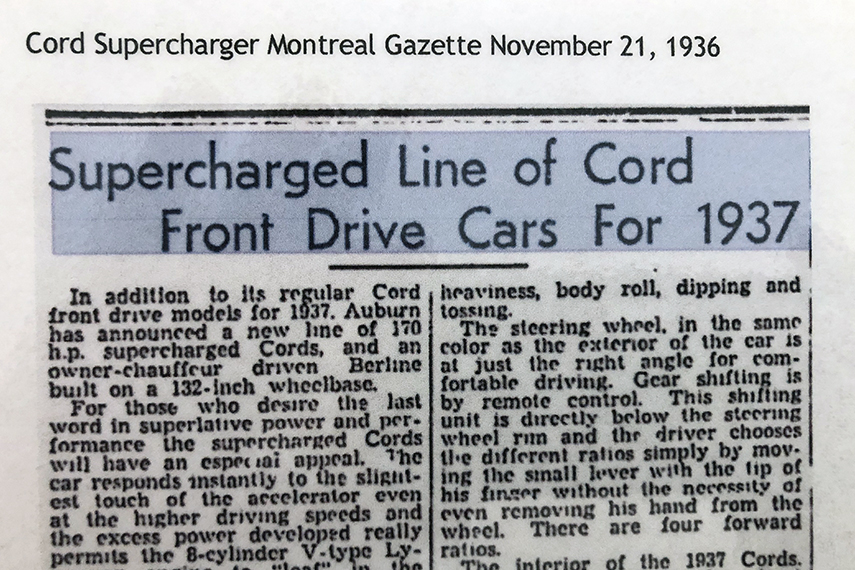
Cord 810/812
The Cord 810, and later Cord 812, was a luxury automobile with lush interiors, and many world and industry first’s.
For the most part, the Cord could be considered a coach-built automobile, as virtually every vehicle had customer tailored paint and interiors. In 1936 the Auburn factory announced a listing of new options, and that special paint and interiors could be ordered for as low as an additional $90. Gordon Buehrig often stated that the Auburn Company was so desperate to make sales it would paint cars in special colors to special order and at extra cost. A great example is the Tom Mix Phaeton which was cigarette cream, with cowhide interiors and a bustle back trunk [one of two produced]. At least one Cord Cabriolet was built with a rumble seat, and one was built with a solid top. The documents below were found by Rick Hulett many years ago in Auburn. Rick has often stated that Cords were built with leather interiors in Sedan car and that special paints were offered.
For unknown reasons, the current Judging Standards do not recognize the Teefy Seltz price list, the Auburn Automobile Company memo nor Gordon Behring’s recollections. This fact results in quality restorations receiving lower judging scores and discourages collectors from further improving their Cords.
‘The Single Most Beautiful American Car’
The Cord was produced by the Cord Automobile division of the Auburn Automobile Company in 1936 and 1937. It was the first American-designed and built front wheel drive car with independent front suspension. Both year models were the first to offer hidden headlights, steering wheel horn rim [a safety feature], covered locking gas filler and many more unique features.
The design of the Cord 810/812 remains one of the most distinctive of the 20th Century. In 1996, American Heritage Magazine proclaimed the Cord 810 sedan ‘The Single Most Beautiful American Car’.
Designed by the celebrated designer Gordon Buehrig, it was one of eight cars chosen for the Museum of Modern Art’s [MOMA] ‘Eight Automobiles’ exhibition in 1951.
Despite springing from the Auburn-Cord-Duesenberg company’s desire to create a lower-cost “Baby Duesenberg,” the striking 1937 Cord 812 was more than a bridge model—it was a landmark of American automotive design. Contemporary reviewers raved over the 810/812, saying “For sheer taste, for functional correctness, and for beauty, the Cord is the best design the American industry has ever produced.”
- An industry first — America’s first front wheel drive, L-29, based on the Miller patent
- An industry first — Hidden headlamps (a world-first),
- An industry first — The famous louvered ‘coffin-nose hood’ [wraparound grille]
- An industry first — Steering wheel horn ring, patented,
- An industry first — Locking covered gas cap,
- An industry first — Exterior concealed filler for coolant,
- An industry first — Exterior concealed filler for engine oil,
- An industry first — Push button engine oil gage which doubled as the gas gage
- An industry first — Engine-turned dashboard, complete instrumentation, including tachometer, and radio
- An industry first — Rear-hinged hood,
- An industry first — Elimination of the era-essential running boards,
- An industry first — Hidden door hinges,
- An industry first — A ‘step-down’ floor,
- An industry first — Unibody construction,
- The Phaeton Sedan had roll-down rear quarter windows, another Cord first for an American production model
- All-steel body, built by Central Manufacturing Co.
- Independent front suspension
- Four-speed gearbox with electric, vacuum assisted shifting
- Lycoming engine, 125hp V-8 with three main bearings
- Startix automatic engine starting mechanism which starts the engine and, restarts engine if it stalls
- Without driveshaft and transmission tunnel, the new car was so low it required no running boards
- Front wheel drive means a flat floor allowing and a roomier cabin
- Use of a full spectrum of car colors which revolutionized the industry
- Supercharger option with side pipes added by Alex Tremulis, designer of the Tucker ‘Torpedo’
- In 1937 achieved a land speed record which stood for 17-year,
- Supercharger option boasts a 150-mph speedometer
- Variable-speed windshield wipers
- Lycoming aluminum cylinder heads, patented
- Phaeton Sedan was a convertible club coupe with pivoting, crank-down rear quarter windows, another U.S. production first
- The Phaeton and Cabriolet’s cloth tops lower into a well, completely concealed by a close-fitting metal cover
Debut of the 1936 Cord 810
On August 10, 1935, just 15 weeks before the first of the big national auto shows [the 1935 New York Motor Show] and the debut of the 1936 Cord 810, Cord Corporation President, E.L. Cord inexplicably announced that production of his new namesake would get underway immediately at Auburn’s Connersville, Indiana facility. Initial funds would come from one of his corporation’s few profitable divisions, a maker of metal kitchen cabinets.
Hopes were high in the lead-up to the unveiling of the Cord 810, at the 1935 New York Motor Show. The Cord 810 predecessor, the L-29, had become America’s first front-wheel-drive car. This led to Cord becoming famous for marrying innovative features to beautiful coachwork – and the 810 would only strengthen this reputation. The 1935 New York Motor Show was a great success, with the attendees of the 1935 New York Motor Show standing on competitor’s car’s in order to get a good look at the new Cord. The new Cord overshadowed everything else on the show floors with its breathtaking lines, hidden headlamps and door hinges, lack of an upright radiator grille, low stance, and futuristic dashboard. One of the most famous reactions, “It didn’t look like an automobile. Somehow it looked like a beautiful thing that had been born and just grew up on the highway.”
Designed by the celebrated designer Gordon Buehrig, it was one of eight cars chosen for the Museum of Modern Art’s ‘Eight Automobiles’ exhibition in 1951. Interestingly, Its shape was based on drawings by Gordon Buehrig that had been soundly rejected in 1933 by his then-boss, General Motors design king Harley Earl.
In September of 1951, the Museum of Modern Art in New York decided to exhibit iconic automobile design as pure elements of art & design. Arthur Drexler curator of the Museum of Modern Art, declared: “We regard the Cord as the outstanding American contribution to automobile design.”
The following is a listing of the selection:
- 1936 Cord 810/812 designed by the celebrated designer Gordon Buehrig,
- 1941 Lincoln Continental coupe, developed by and for Edsel Ford,
- 1948 MG TC
- 1937 Talbot-Lago teardrop coupé,
- 1939 Bentley saloon with coachwork by James Young
- 1928 Mercedes Benz SS Tourer
- 1947 Cisitalia 202 coupé, Farina designed from sketches by Cisitalia’s Giovanni Savonuzzi the car that “transformed postwar automobile design”
- 1951 military M-38 Jeep (“a masterpiece of functionalist design”)
The MoMA exhibit was called “Eight Automobiles,” and in favor of either expensive luxury cars (Mercedes and Bentley) or small functional cars (MG). Three American cars were included, but two were limited-run luxury cars (Lincoln Continental and Cord) and the other was a military vehicle, the Jeep. An exhibition concerned with the aesthetics of motorcar design, at the Museum of Modern Art, New York, autumn 1951. The exhibition is made possible through the generosity of the Ford Motor Company, The Studebaker Corporation, Willys-Overland Motors, Inc., and the individuals who have lent automobiles.
Today’s generation of young car enthusiasts have no idea how innovative the cars of Errett Lobban Cord were when they were introduced more than 80 years ago, with their front-wheel drive and hideaway headlamps. Cord’s cars are among the most influential American cars ever built. Although his empire lasted much longer than Preston Tucker’s, Errett Lobban Cord’s life resembled Tucker’s. Cord was part promoter, part visionary. He tried exceedingly hard to succeed, but like Tucker, fell hard. His ultimate creations were the Cord L-29 and 810/812. Cord was a salesman and business tycoon, who was drawn to the car-making business because of its money-making possibilities. In 1924, when he was just 30 years of age, Cord took over the day-to-day operations of the Auburn brand. Rather than focus on the conservative design of the day, Cord focused on cosmetics, and Auburns almost overnight were transformed into some of the best-looking cars on the road. Success seemed imminent because they were both technical and styling masterpieces.
The heart of the Cord was the front-wheel-drive system, pioneered by Harry Miller on the American champ car race circuit. Cord was so enamored with this revolutionary system that he bought the patent rights from Miller, and an early L-29 prototype took shape in Miller’s Los Angeles race car shop. We all know the benefits of front-wheel drive, but it’s been said that Cord didn’t care about the mechanical end of it, but rather the styling advantages front-wheel drive offered him. Cord himself did not design the car’s gorgeous body; John Oswald, who had designed many Auburns, drew the lines of the L-29, whose hood line sat a foot lower than its luxury car competition.
Like many other companies at the time, Cord succumbed to the Great Depression, and production stopped on New Year’s Eve 1931. But he returned four years later with arguably the most recognizable car in American history-the Gordon Buehrig-designed Cord 810. With its long, upright hood and horizontal band of trim, the car soon earned the nickname “coffin-nose,” to which it is still referred today. While other American cars had externally mounted door hinges, Buehrig included concealed hinges in the revolutionary design, and full-face wheelcovers. The headlamps, an industry first, were concealed in the fenders, and were raised by way of a pair of small cranks, one at either end of the dashboard.
The 1936 810’s engine was a Lycoming 125hp V-8 with three main bearings. This did not change for the 812 model in 1937, but now a supercharger became available, and this boosted horsepower substantially to an advertised 170hp at 3,500 rpm. The actual rating was 195hp at 4,200 rpm (gross). The L-head V-8 in non-supercharged form displaced 288.6 cubic inches, with a bore and stroke of 3.50 inches x 3.75 inches, respectively. The compression ratio, typical of the time, was 6.3:1, while a Stromberg AA25 duplex carburetor and mechanical pump supplied the fuel. The engine featured aluminum cylinder heads, to take advantage of the heat-dissipating benefits, but strangely, only a single exhaust was used and, of course, a six-volt electrical system.
There were four models in 1936: Westchester Sedan, Beverly Sedan, Sportsman and Phaeton. All rode on 125-inch wheelbases. In 1937, two models, the Westchester and Beverly sedans, kept their 125-inch wheelbase, but the other four models- Cabriolet [aka Sportsman, convertible coupe], Phaeton, Custom Beverly and Custom Berline-had longer, 132-inch wheelbases. The longer-wheelbase cars had eight louvers on the hood side panels, with the shorter-wheelbase cars having seven louvers.
In 1936, Cord built 1,764 cars, and in 1937, just 1,066 cars were built. No supercharged Cords were built in 1936, but in 1937, about 40 percent of production were supercharged. In 1937, just 11 Berlines were built featuring their characteristic roll-up partition between the front and rear seats and rear instrument panel.
Driving Impressions
The Cord is very advanced for its time, performs and handles well and is beautiful, even by today’s standards. If one drives a Cord for the first time, they find that acceleration is smooth and, while not packing supercharged power, acquits itself admirably. The transmission shifts smoothly and the U-joints are silent. The manual steering is effortless on the straights, even with bias-ply tires, and the ride is comparable to modern automobiles. This is due to the transverse leaf spring, trailing swing arms and center point steering. For a heavy car, it handles well, and can be driven 20 mph faster around a curve than a normal rear-wheel-drive car because there’s less unsprung weight, and the car is much lower to the ground than other cars built in the 1930’s. At slow speeds, the car feels heavy, but at speed it handles quite well. It is a good stable car and can be driven between 75 and 80 mph on the open highway with no trouble. The supercharged cars will run 110 to 115 mph.
The 1936-1937 Cords had uni-body construction with an all-steel body, built by Central Manufacturing Co., with the powertrain carried on stub-type sub-frame. The transmission is a Detroit Gear T2971 and a four-speed unit with a dry clutch. The shifter pre-select is an electrically operated unit made by Bendix. The transmission itself was made in Auburn, Indiana, and the spiral bevel differential carried semi-floating drive axles with a 4.7:1 ratio.
Model 810/812 Cord Beverly production over the two model years was 1,146
Only 688 Cord 812 cars of all styles were factory-equipped with the supercharged “FC code” engine. This version of the Cord Lycoming V8 reportedly developed around 190 hp, thanks to its Switzer-Cummings supercharger and aggressive camshaft. The standard Cord electric pre-selector 4-speed transmission was retained with the blower engine.
Original list for a Supercharged Beverly Sedan was $2960, a $415 premium over the standard non-supercharged 1937 Beverly.
In June 1937, famed driver Ab Jenkins won the Stevens Challenge Trophy for Cord. Wheeling a Supercharged Beverly—the same model offered here—Jenkins averaged 79.58 mph while covering a record 1909.851 miles in 24 hours at the Indianapolis Speedway. The Cord record stood until 1954 and it took a Chrysler FirePower “hemi” V8 to finally topple it.
Authenticity is attested to this Supercharged Beverly’s A-C-D Club Category 1 certification.
Fewer than fifteen restored Cord Beverly models are said to exist.
Automotive history has its dark side. There have been thousands of auto manufacturers in America, and only a few remain. The inescapable conclusion is that nearly all automakers ultimately fail. Most do not die well. Car companies are founded on brave promises of innovative design and bold engineering. They end with one last run of unwanted cars, thrown together from the surplus inventories of disproven ideas and leftover parts.
Not the Auburn Automobile Company. It went down firing its best shots. By 1935, the Indiana car maker’s sales had dried up and its dealers were vanishing. The end was coming, and everyone had to know it. Yet Auburn managed to exit the scene with one original, magnificent and—so far as the company’s future was concerned—totally futile gesture: the Cord 810.
With its striking, louvered nose and groundbreaking hidden headlights, the Gordon Buehrig-designed Cord 810 looked nothing like the conservative offerings from the big Motor City manufacturers in mid-depression. The 810′s engineering was also audaciously original—impossibly so for a small, shaky operation like Auburn. Cord’s then-radical front-drive system would have taken a General Motors millions of dollars and years to perfect, had it the guts to even try. The Auburn engineers didn’t have the resources, or even much time left, but they did have the nerve. The Cord 810 went from prototype to production in less than 240 days.
The first Cord front driver of 1929, the L29, used a conventional drive train turned around backward—a crude, ineffective package. With the 810, Cord historian Josh Malks says Auburn carefully studied the Citroen Traction Avant layout, which underneath, the 810 more closely resembles. The 810′s drive train sat on a front stub frame that attached to a unitized cab structure, just like the next American front-drive three decades later, the Olds Toronado. The Cord’s front suspension was not predictive of anything, employing a ponderous trailing arm hung on a gigantic pivot on each side.
The transaxle was a departure as well, and the weakest link of all. It remained woefully underdeveloped as Auburn engineers improvised desperate revisions well into production. Inside the unit was a conventional synchronizer gearbox controlled via Bendix Fingertip Control, previously offered by Hudson. The vacuum-electric setup was moody, but Auburn had no time to develop a mechanical linkage.
Since the box was designed as a three-speed, its four forward gears were undersized, generating excessive friction and heat. The gear-set hung on a long, whippy input shaft that extended out over the differential, with the whole works encased in an integrated housing that proved impossible to lubricate. The ad-lib design was prone to hammering out its thrust spacers, jumping out of gear, or simply seizing up altogether.
On the other hand, the Cord’s Lycoming V8 was as advanced as any flathead could be in 1936. The camshaft rode high in the block, angling the valves nearly 45 degrees—semi-overhead valves, if you will. The 289 CID developed 125 hp in standard, normally-aspirated form, enough to propel the 3800-lb. Cord to 100 mph. On the 1937 812 model, an available centrifugal supercharger boosted the output to 170 hp.
1937 Cord 812 Westchester vs. 1937 La Salle Series 50
The world of automobiles is littered with high-end marques that didn’t make it. Rarely have two cars aimed at the same market been so utterly different. They were priced a thousand dollars apart-$1,445 for the La Salle versus $2,445 for the Cord-in an era when a thousand dollars could buy a whole new car outright. One sold 32,000 units, the other was the last gasp of a rapidly dying company. One was utterly conventional, the other was the avant-garde of automotive technology-yet the engines powering both were roughly comparable in power. One has a museum dedicated to its greatness, the other has no such edifice erected in its honor. One is regularly named to lists of the world’s most beautiful cars, while the other shows up nowhere. Both marques had been relieved of the burden of existence by the dawn of the Second World War-one in a fit of corporate rationalization, the other for myriad reasons that resulted in bankruptcy. Yet nearly 70 years on, history regards one as a milestone automobile, while the other languishes in books and in the garages of a handful of loyalists.



